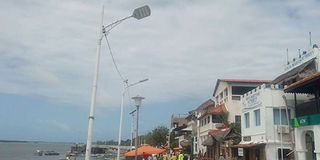The changing face of Lamu

Solar-powered street lamps installed in Lamu Old Town. Lamu is a pearl to be polished and looked after. PHOTO | KALUME KAZUNGU | NATION MEDIA GROUP
What you need to know:
- Stone houses made in the 18th and 17th centuries are still intact. Some are made from dead coral and plastered with limestone.
- In a fast-changing world where everything is moving towards modern technology, we should leave Lamu untouched.
A Unesco World Heritage Site and the oldest continually inhabited town along the Kenyan coast, Lamu Old Town has retained its authentic Arabic architectural fabric as well as its social and cultural mores, making for a rich and authentic getaway.
We book a stay at Subira House, a budget place that stands right behind Lamu Fort and is a key example of Omani architecture of eras past.
There are a few key structural differences with surrounding Swahili houses, including higher ceilings for self-ventilation, the absence of zidaka niches and a more grandiose air about the space.
I am curious to find out more about the architecture in this town, and so the owner, who doubles as a manager, hires one of his go-to guides to show us around.
Being a Muslim town, the best time to go on a walking tour is in the morning as the town generally comes to a close at 12:30pm.
NEIGHBOURLY
We kick off at the waterfront mosque, Msikiti wa Pwani, said to be almost 900 years old.
It gets its name from a high wall which would keep away the water during high tide. The shoreline has since receded.
The alleyways are narrow because when the houses were constructed, no one fathomed that there would one day be cars.
There are cats everywhere. Following the stories, I heard about the black cats in Mombasa as a child; how people in Lamu don't recoil in terror when they see these cats is beyond me.
Stone houses made in the 18th and 17th centuries are still intact. Some are made from dead coral and plastered with limestone. Most houses have wells for freshwater.
Neighbours would join their balconies so they could visit each other without having to go downstairs, and for us, these "roofs" provide respite from the heat.
SANITATION
Each house has a front porch raised a little above the street level and lined with stone seats called a baraza, where people could hang out with the house owner before going about their day.
An intricately carved wooden door (there's a woodwork section in town, in case you're keen to see how they are made) opens to an inner porch overlooking a courtyard if the family has space.
For ventilation, parallel galleries regulate the breeze. There is no modern-day drainage system so bathwater runs through narrow channels constructed into the side of each house, depositing into the sea.
Some houses have a birika, a bath which is filled with water and looks like a little pond, complete with tiny fish said to ward off mosquitoes and keep the bath clean.
Zidaka niches are outfitted with decorative porcelain plates and metallic incense holders. It is such a stark difference from Nairobi.
TECHNOLOGY
Our guide gets us some labaneer, a really sweet candy made with milk, sugar, and cardamom. And as I tear off a piece, I can't help but think about how much Lamu is changing (or how this sweet could give me diabetes).
This thought continues to run through my mind when, back on the balcony of my room, a delightful chorus of evening birds is interrupted by rap music blaring from a boda-boda in the alleyway below.
These motorbikes that whizz past on the narrow streets, jostling for space with pedestrians, are so out of place in this ancient backdrop.
In a fast-changing world where everything is moving towards modern technology, we should leave Lamu untouched.
It's the innocence that still continues to draw visitors to shoreline with so many other splendid beaches. Lamu is a pearl to be polished and looked after.
I want to enjoy its present state while I still can. And so I sit on the rooftop of the house tucking into freshly baked bread with a delicious homemade jam whose recipe I've already slipped into my pocket, taking in the surrounding sea of houses and listening to the innocent song of nursery-age kids singing their ABC's in a nearby class.




